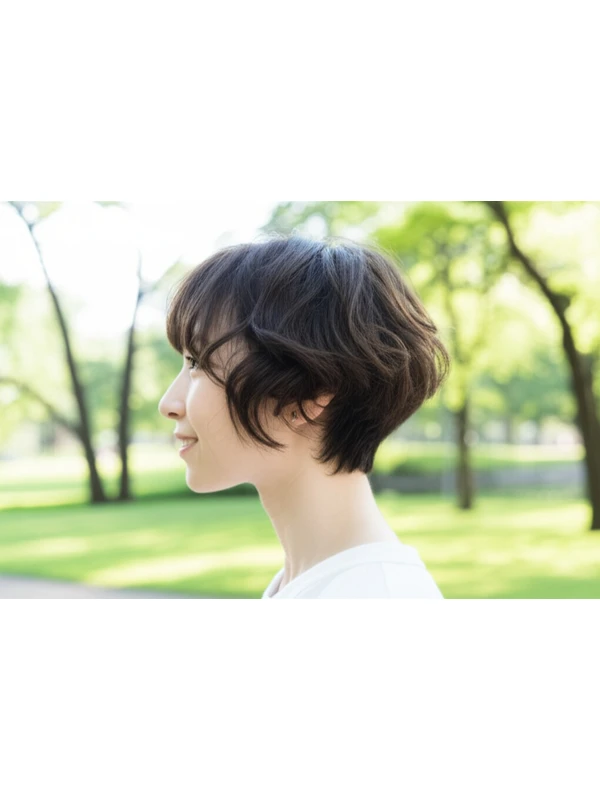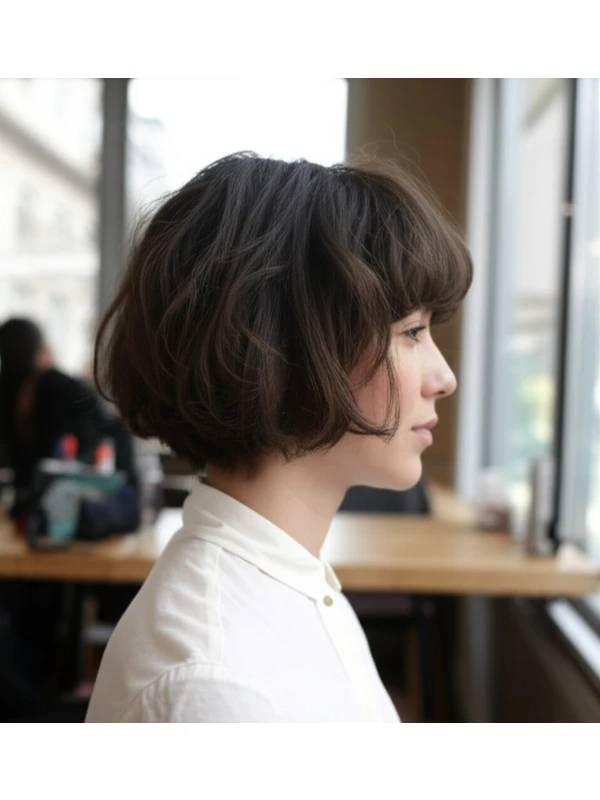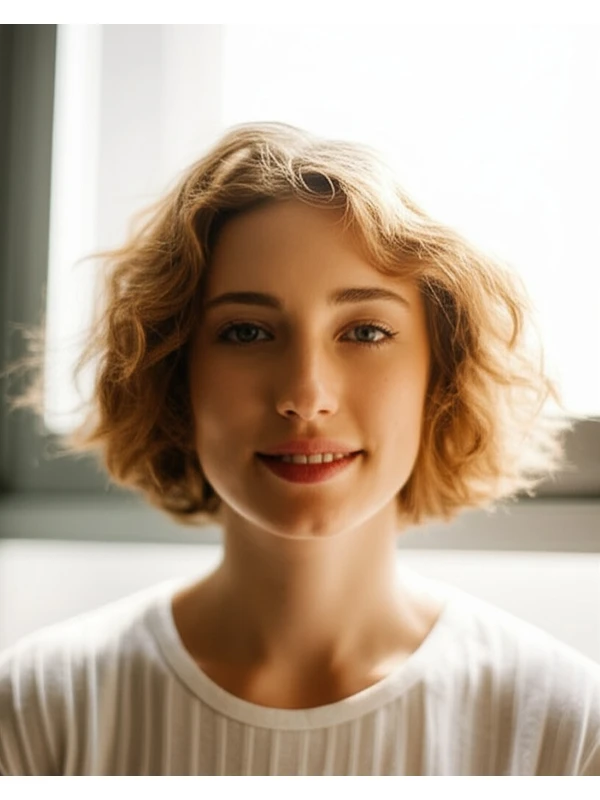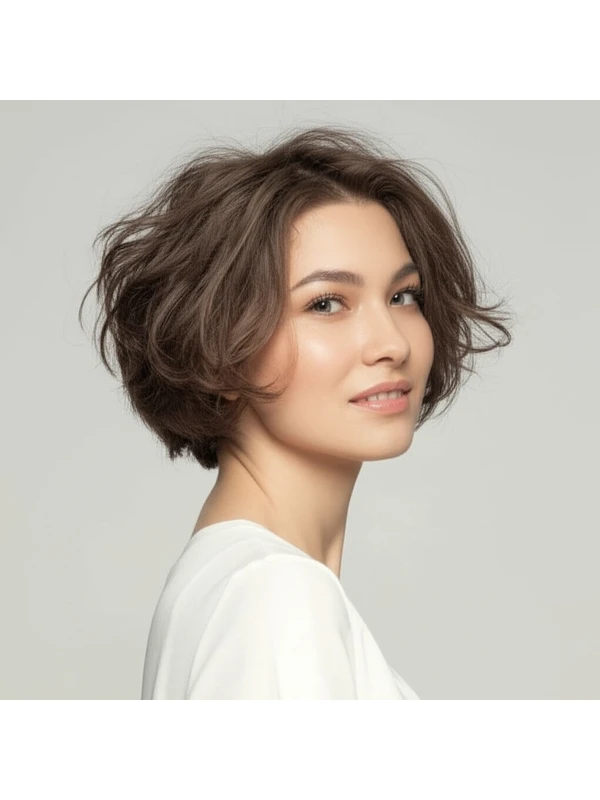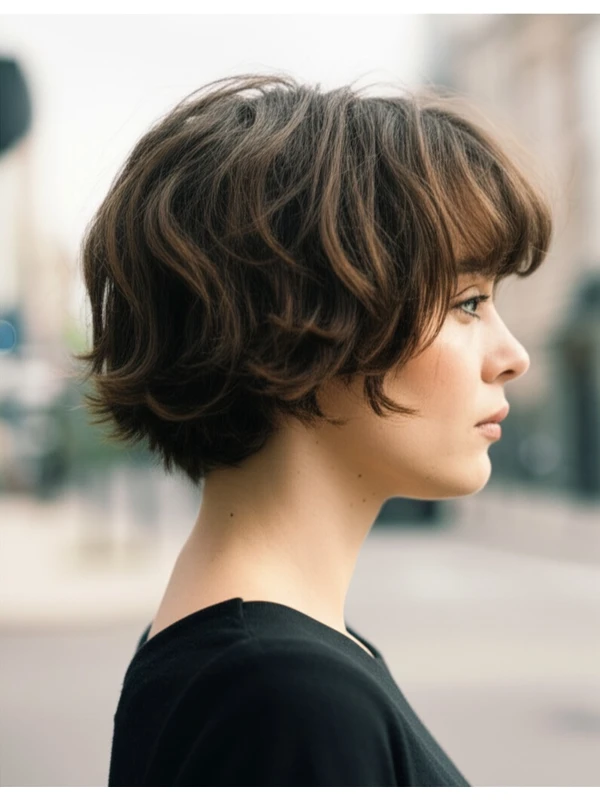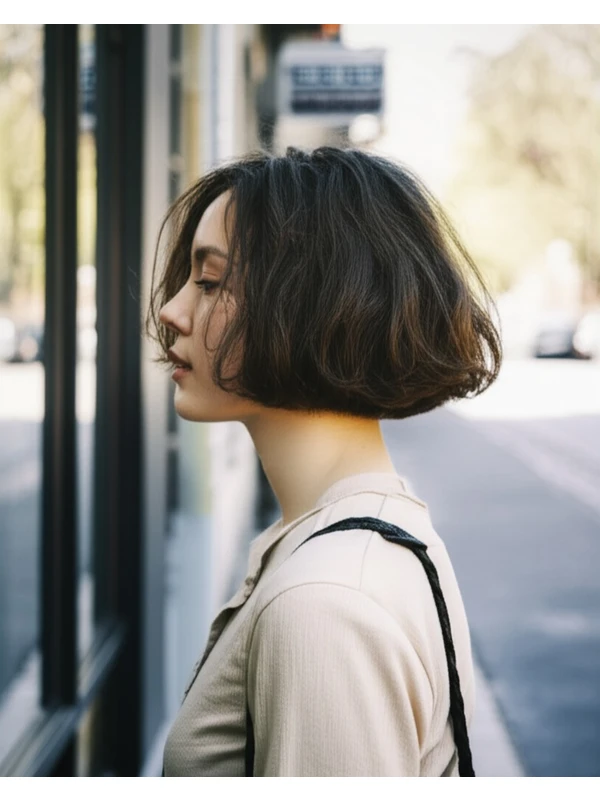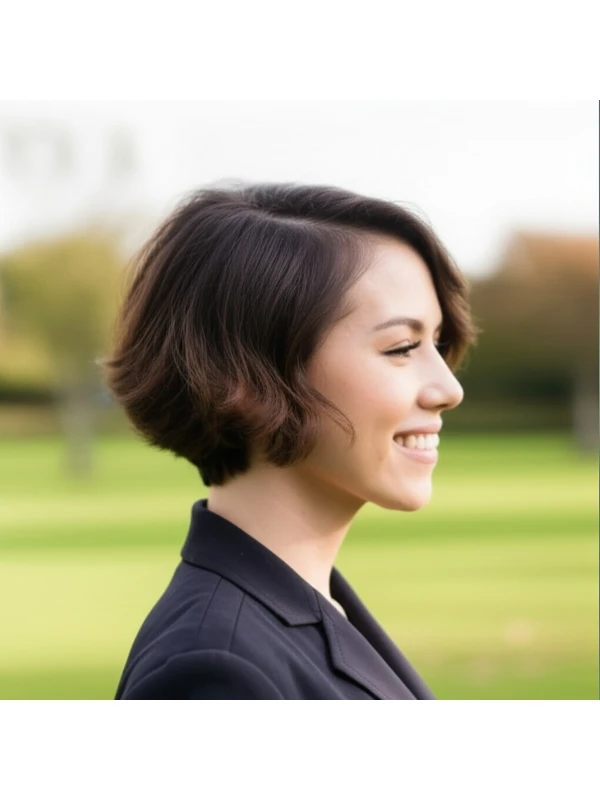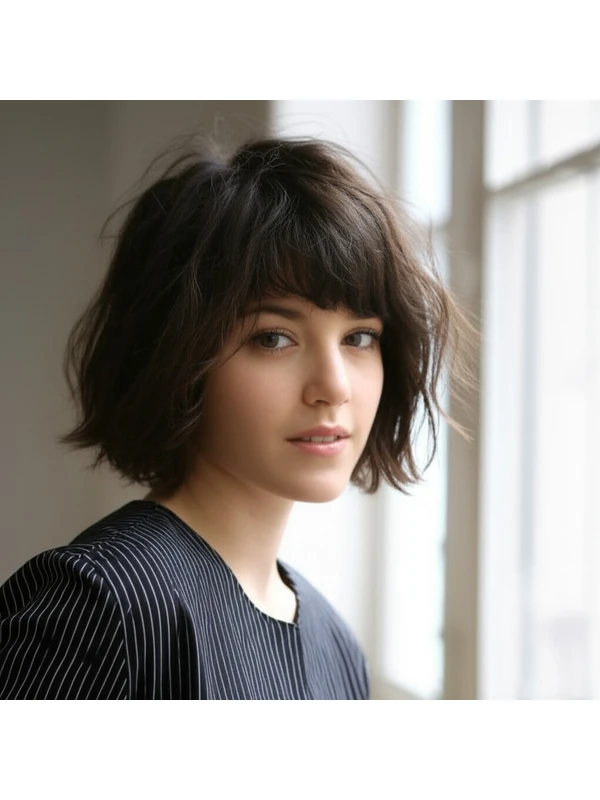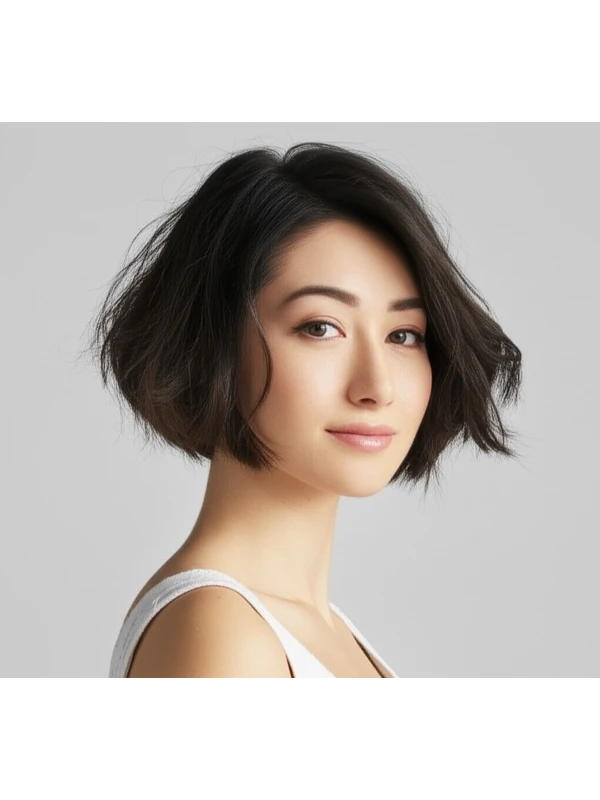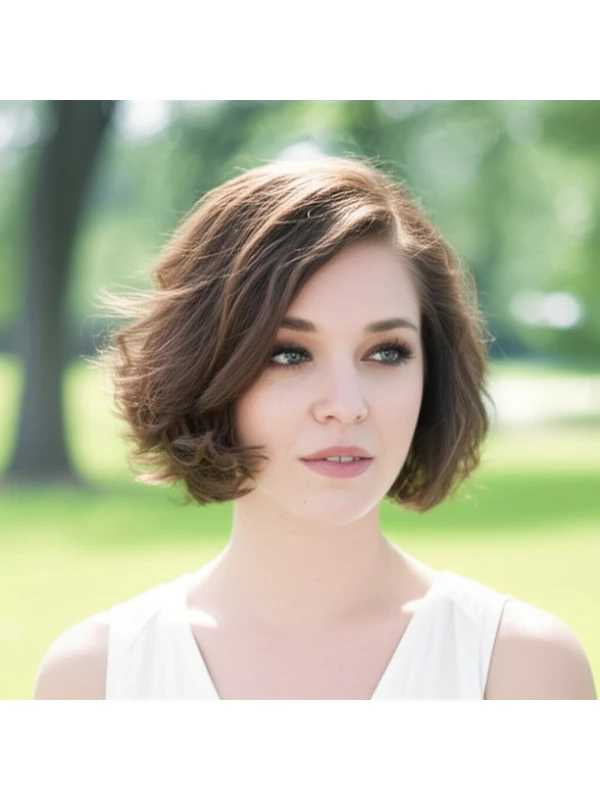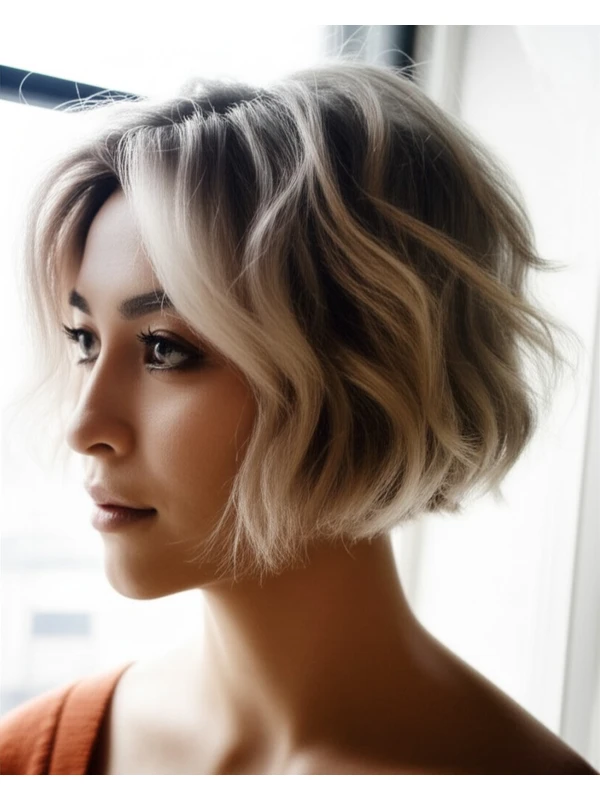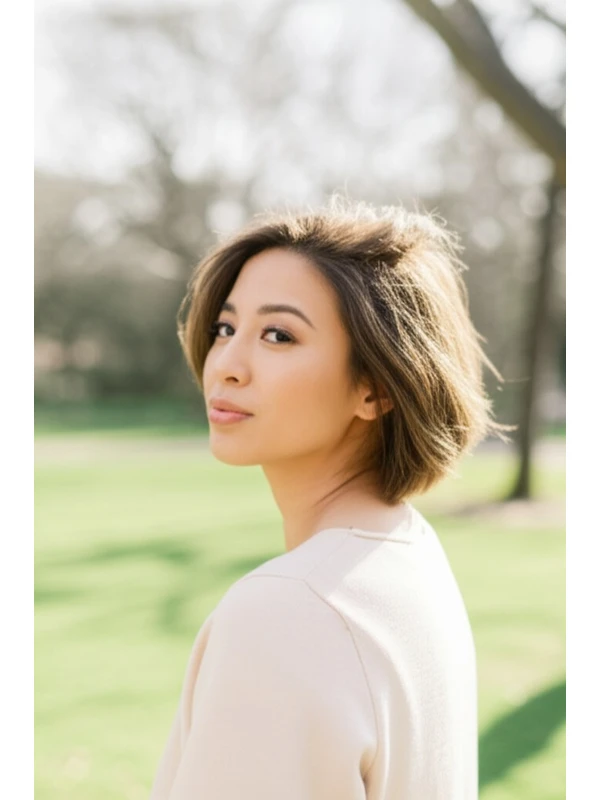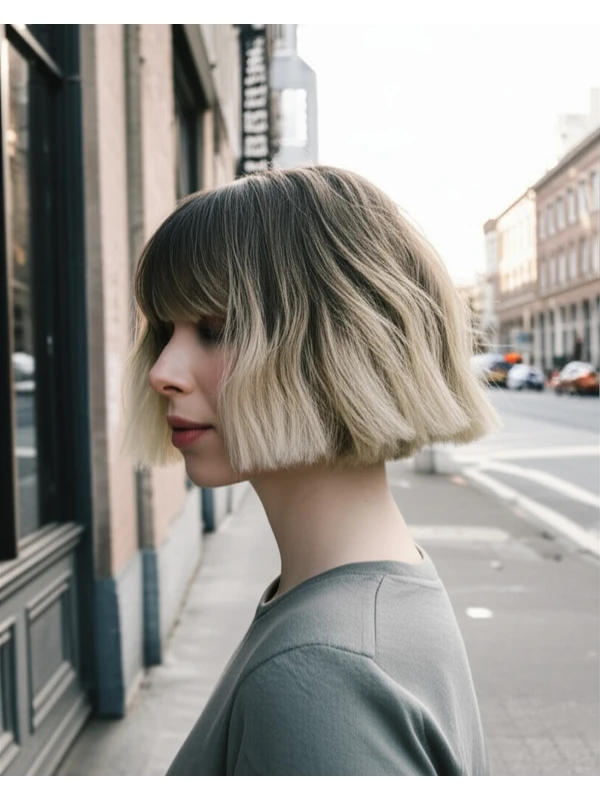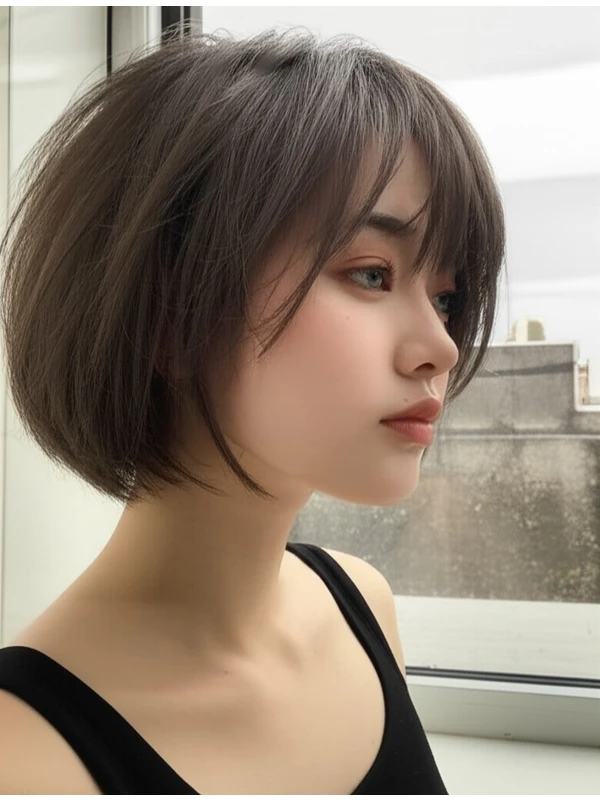#The Bubble Bob: A Playful & Modern Hairstyle
The "Bubble Bob" hairstyle is having a major moment! It’s popping up everywhere on social media and red carpets alike, but what exactly is it? This guide will break down everything you need to know about the Bubble Bob – from its origins and suitability for your face shape to how to style and maintain this fun, flirty look.
#1) Background & Definition: What is a Bubble Bob?
The Bubble Bob gets its name from its resemblance to bubbles floating around your head. It’s essentially a rounded bob with significant volume at the crown (the top of the head). Think playful, bouncy, and effortlessly chic.
- Cut Geometry: The cut features short layers that are longer than traditional bobs – usually hitting anywhere between chin length and just below the collarbone. The key is creating a dome-like shape on top with lots of movement.
- Key Features: Volume at the crown, rounded silhouette, soft layers, often face-framing pieces.
- Typical Length Ranges: Chin to mid-collarbone (15cm - 23 cm approximately). Shorter versions are bolder; longer versions feel softer and more classic.
- Alternative Names: Rounded Bob, Voluminous Bob, Dome Bob, Cloud Bob (due to its fluffy appearance).
#2) Face Shape Fit: Finding Your Best Bubble Bob Angle
The beauty of the Bubble Bob is that it can be adapted for most face shapes! However, some adjustments might be needed.
- Oval: Lucky you! The Bubble Bob looks fantastic on oval faces as the rounded shape complements their balanced proportions. A middle part usually works best.
- Fringe Option: A soft, wispy fringe or curtain bangs would enhance the softness of this face shape.
- Round: To avoid emphasizing roundness, opt for a slightly longer Bubble Bob that falls below the chin. Volume at the crown helps elongate the face. Avoid too much volume around the cheeks.
- Fringe Option: Side-swept fringe or long, angled bangs can create asymmetry and slim the face.
- Square: The roundness of the Bubble Bob softens a square jawline. Layering is key to avoid harsh lines.
- Fringe Option: A soft, textured fringe that blends seamlessly into the layers will soften angles.
- Heart: A slightly longer Bubble Bob balances a wider forehead and pointed chin. Volume at the sides helps create balance.
- Fringe Option: Wispy, side-swept bangs or curtain bangs can minimize forehead width.
- Diamond: The rounded shape of the Bubble Bob softens diamond face shapes’ angular features. Strategic layering around the cheekbones is important to avoid emphasizing angles.
- Fringe Option: A soft, blended fringe that doesn't overwhelm the eyes works well.
- Oblong: Similar to round faces, a longer Bubble Bob with volume at the sides helps shorten and widen an oblong face shape.
- Fringe Option: A full, blunt fringe can help visually shorten the length of the face – but proceed cautiously as it can also look heavy.
#3) Body Proportions & Height Guidance: Tailoring the Bubble Bob to You
The Bubble Bob’s impact is influenced by your overall body shape and height.
- Petite: A shorter, more compact Bubble Bob (chin length or slightly longer) will prevent you from being overwhelmed by the volume.
- Average Height: Most lengths work well! Experiment with different volumes at the crown to find what suits you best.
- Tall: A longer Bubble Bob that falls just below the collarbone can create a more balanced look.
- Narrow Shoulders: Volume at the crown will visually broaden shoulders, creating balance.
- Broad Shoulders: Be mindful of adding too much volume on top; it could exaggerate shoulder width. A slightly sleeker style might be preferable.
- Short Neck: Avoid a very short Bubble Bob as it can make your neck appear shorter. Opt for longer layers and more volume at the sides to elongate the neckline.
- Long Neck: The Bubble Bob is generally flattering, but you can play with different lengths to find what feels most comfortable.
#4) Works Best With Hair Types & Densities: Finding Your Ideal Match
The Bubble Bob’s versatility shines through its adaptability across hair types and densities.
- Straight Hair: Easily achieves the rounded shape! Styling products like mousse can enhance volume at the crown.
- Wavy Hair: The natural wave adds beautiful texture and movement to the style. Use a curl-enhancing product for definition.
- Curly/Coily Hair: Requires careful layering to prevent bulkiness and ensure even distribution of curls/coils. Shrinkage is crucial to consider – what looks like chin length when dry will be much shorter when curly! Consult with a stylist experienced in cutting textured hair.
- Density Tip: Fine hair benefits from layers to create the illusion of volume. Thick hair may need more thinning and shaping to avoid looking heavy.
- Fine Hair: Layers are essential for creating volume, but don’t overdo it – too many layers can make fine hair look even thinner.
- Medium/Thick Hair: The Bubble Bob thrives with medium to thick hair as it provides the foundation for the signature volume.
#5) Styling Variations: From Casual Cool to Evening Glam
The Bubble Bob is a chameleon! Here's how to change its vibe:
- Sleek vs Textured: Sleek styles use smoothing serums and flat irons for a polished look. Texturized styles embrace natural waves or curls with texturizing sprays.
- Middle vs Side Part: A middle part creates symmetry, while a side part adds softness and asymmetry.
- Fringe Variations: Blunt bangs, wispy fringe, curtain bangs – the possibilities are endless!
- Occasion Styling:
- Casual: Air-dried with a texturizing spray for effortless cool.
- Office: Sleek and polished with a smoothing serum and minimal heat styling.
- Evening: Add volume at the crown using volumizing mousse or root lifter, then finish with hairspray.
#6) Maintenance: Keeping Your Bubble Bob Blooming
Regular trims are key to maintaining shape!
- Trim Cadence: Every 6-8 weeks for most hair types; more frequently (every 4-6 weeks) for curly/coily hair due to shrinkage and growth patterns.
- At-Home Routine: Gentle shampoo and conditioner, leave-in conditioner (especially important for dry or textured hair).
- Heat vs Air Dry: Minimize heat styling whenever possible. When using heat, always use a protectant spray!
- Product Checklist: Shampoo & Conditioner, Leave-In Conditioner, Volumizing Mousse/Root Lifter (optional), Texturizing Spray (for texture), Hairspray (for hold).
- Estimated Daily Styling Time: 5–15 minutes depending on desired style and hair type.
#7) Grow-Out Roadmap: Evolving Your Look
The Bubble Bob evolves beautifully as it grows out.
- Months 1-3: The shape is most defined, requiring regular trims to maintain the rounded silhouette.
- Months 4-6: Layers start to blend together, creating a softer look. You can experiment with different styling techniques.
- Maintenance Between Cuts: Use dry shampoo at the roots for added volume and texture. Consider a gloss treatment to refresh color.
#8) Color Pairings: Enhancing Your Bubble Bob’s Beauty
Color can dramatically elevate this style!
- Shades that Elevate: Balayage, babylights, or face-framing highlights add dimension and movement.
- Cool Undertones: Ashy blondes, cool browns, silver/grey tones.
- Warm Undertones: Honey blondes, caramel browns, copper shades.
- Low-Commitment Options: Root shadows (blending the natural root color with a darker shade) or gloss treatments to enhance shine and tone.
#9) Season & Occasion Guide: Adapting Your Style
- Spring/Summer: Embrace lighter textures – air dry, use texturizing sprays for effortless beachy vibes.
- Fall/Winter: Add warmth with richer tones and a touch of shine. A sleek style can be very chic in colder months.
- Work: Sleek and polished, keeping the focus on professionalism.
- Weddings: Soft waves or curls add romance and elegance.
- Parties: Experiment with bolder styling techniques – volume at the crown, playful accessories.
#10) Cost & Time: What to Expect in the Salon
- Salon Time: Typically 45-90 minutes for a first cut; shorter for trims.
- Estimated Price Range: Expect to pay more than an average trim but less than a complex color treatment – prices will vary significantly depending on location and stylist experience.
#11) Pros & Cons: Weighing the Trade-offs
Pros: Versatile, flattering on many face shapes, playful and modern, relatively easy to style (depending on hair type). Cons: Requires regular trims, can be time-consuming to style for certain looks, may not suit extremely fine or very thick hair without careful tailoring.
#12) Salon Consultation Script: Questions to Ask Your Stylist
- "I'm interested in a Bubble Bob hairstyle. Can you assess my face shape and recommend adjustments?"
- "Given my hair type [straight/wavy/curly/coily] and density, what length would be most flattering?"
- “How much volume do you think I should incorporate at the crown?”
- "I'm concerned about shrinkage. How can we account for that in the cut if I have curly or coily hair?"
- "Can you show me examples of different Bubble Bob styles and explain how they would work with my hair?"
#FAQs: Your Burning Questions Answered
- Is a Bubble Bob hard to style? It depends on your hair type! Straight hair is generally easier, while curly/coily hair requires more technique.
- Can I do this myself? A trim is possible at home but the initial cut is best left to a professional for optimal shape and layering.
- What if my bangs don't lie flat? Use a small amount of styling cream or serum to smooth them down.
- Will the volume at the crown make my head look bigger? Not necessarily! The roundness balances proportions, but discuss concerns with your stylist.
- How do I prevent my Bubble Bob from looking too "puffy"? Proper layering and a good cut are essential. Avoid overly volumizing products near the face.
- Can I wear it in a ponytail? Yes! However, you may need to adjust the volume at the crown beforehand for a cleaner look.
